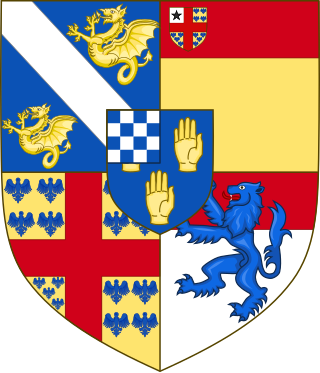
The House of Guise was a prominent French noble family that was involved heavily in the French Wars of Religion. The House of Guise was the founding house of the Principality of Joinville.
Monsieur is an honorific title that was used to refer to or address the eldest living brother of the king in the French royal court. It has now become the customary French title of respect and term of address for a French-speaking man, corresponding to such English titles as Mr. or sir.

Amphiptere is a type of winged serpent found in European heraldry.

The House of Lorraine originated as a cadet branch of the House of Metz. It inherited the Duchy of Lorraine in 1473 after the death without a male heir of Nicholas I, Duke of Lorraine. By the marriage of Francis of Lorraine to Maria Theresa of Austria in 1736, and with the success in the ensuing War of the Austrian Succession (1740–1748), the House of Lorraine was joined to the House of Habsburg and became known as the House of Habsburg-Lorraine. Francis, his sons Joseph II and Leopold II, and his grandson Francis II were the last four Holy Roman emperors from 1745 until the dissolution of the empire in 1806. The House of Habsburg-Lorraine inherited the Habsburg Empire, ruling the Austrian Empire and then Austria-Hungary until the dissolution of the monarchy in 1918.

Duke of Bourbon is a title in the peerage of France. It was created in the first half of the 14th century for the eldest son of Robert of France, Count of Clermont, and Beatrice of Burgundy, heiress of the lordship of Bourbon. In 1416, with the death of John of Valois, the Dukes of Bourbon were simultaneously Dukes of Auvergne.
Count of Guise and Duke of Guise were titles in the French nobility.

Fils de France was the style and rank held by the sons of the kings and dauphins of France. A daughter was known as a fille de France.

The House of Rohan is a Breton family of viscounts, later dukes and princes in the French nobility, coming from the locality of Rohan in Brittany. Their line descends from the viscounts of Porhoët and is said to trace back to the legendary Conan Meriadoc. Through the Porhoët family, the Rohans are related to the Dukes of Brittany, with whom the family intermingled again after its inception. During the Middle Ages, it was one of the most powerful families in the Duchy of Brittany. The Rohans developed ties with the French and English royal houses as well, and they played an important role in French and European history.

Duke of Brissac is a title of French nobility in the Peerage of France, which was originally created in 1611 for Charles II de Cossé, Count of Brissac. This title has been held since April 2021 by Charles-André de Cossé, who is the 14th Duke of Brissac. The ancestral home of the ducal family is the Château de Brissac, which is still owned by the family.

In the 11th and 12th centuries the Countship of Penthièvre in Brittany belonged to a branch of the sovereign House of Brittany. It initially belonged to the House of Rennes. Alan III, Duke of Brittany, gave it to his brother Eudes in 1035, and his descendants formed a cadet branch of the ducal house.

Louis-Joseph de Montmorency-Laval (1724-1808) was a French cardinal of the Catholic Church and Bishop of Metz at the time of the French Revolution.

The Château de Sceaux is a grand country house in Sceaux, Hauts-de-Seine, approximately 10 km (6 mi) south-southwest of the centre of Paris. Situated in a large park laid out by André Le Nôtre, partly in Antony, visitors can tour the house, outbuildings and gardens.

The Gardes du Corps du Roi was the senior formation of the King of France's household cavalry within the maison militaire du roi de France.

A prince du sang or prince of the blood is a person legitimately descended in male line from a sovereign. The female equivalent is princess of the blood, being applied to the daughter of a prince of the blood. The most prominent examples include members of the French royal line, but the term prince of the blood has been used in other families more generally, for example among the British royal family and when referring to the Shinnōke in Japan.

The military governor of Paris is a post within the French Army. He commands the garrison of Paris and represents all the military based in Paris at high state occasions. He is also responsible for organizing major national ceremonies such as the Bastille Day military parade down the Champs-Élysées.

The Duke of Tresmes was a title in the peerage of France from 1648 to 1670, at which point the title was changed to Duke of Gesvres. Thereafter, the Duke of Gesvres was sometimes referred to as the "Duke of Tresmes and Gesvres" and the title "Duke of Tresmes" was used as a courtesy title for the eldest son of the Duke of Gesvres and "Count of Tresmes" for younger sons.

The House of Potier was a noble house in Ancien Régime France. Members of the Potier family were Nobles of the Robe who gained their prominence through serving the King of France.

Bernardin François Fouquet was a French Catholic prelate, Cardinal, abbot and archbishop of Embrun from 1740 to 1767.